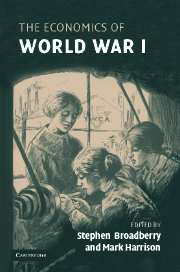Book contents
- Frontmatter
- Contents
- List of figures
- List of tables
- List of contributors
- Acknowledgements
- Introduction
- 1 The economics of World War I: an overview
- 2 The pity of peace: Germany's economy at war, 1914–1918 and beyond
- 3 Austria-Hungary's economy in World War I
- 4 The Ottoman economy in World War I
- 5 Between the devil and the deep blue sea: the Dutch economy during World War I
- 6 Was the Great War a watershed? The economics of World War I in France
- 7 The United Kingdom during World War I: business as usual?
- 8 Poor Russia, poor show: mobilising a backward economy for war, 1914–1917
- 9 Italy at war, 1915–1918
- 10 Until it's over, over there: the US economy in World War I
- Index
- References
6 - Was the Great War a watershed? The economics of World War I in France
Published online by Cambridge University Press: 23 July 2009
- Frontmatter
- Contents
- List of figures
- List of tables
- List of contributors
- Acknowledgements
- Introduction
- 1 The economics of World War I: an overview
- 2 The pity of peace: Germany's economy at war, 1914–1918 and beyond
- 3 Austria-Hungary's economy in World War I
- 4 The Ottoman economy in World War I
- 5 Between the devil and the deep blue sea: the Dutch economy during World War I
- 6 Was the Great War a watershed? The economics of World War I in France
- 7 The United Kingdom during World War I: business as usual?
- 8 Poor Russia, poor show: mobilising a backward economy for war, 1914–1917
- 9 Italy at war, 1915–1918
- 10 Until it's over, over there: the US economy in World War I
- Index
- References
Summary
Introduction
The dominant view is that the ‘Great War’ represented for France the end of an economic and social era that is often considered with nostalgia in France and with condescension abroad. In this view, not only the belle époque but the entire nineteenth century is considered to be an era in which economic liberalism was counterbalanced by a strong state which guaranteed the ‘equilibrium’ of a well-balanced economy of ‘moderate’ industrialisation. This is symbolised by the image of its ‘three pillars’ – agriculture, manufacturing, and services – being of similar size, or by a similar balance between the urban and rural areas. Another view, mostly developed by economic historians, highlights the rapid changes in the French economy and society before the war. Dynamic industrial change was underway, best symbolised by the automobile and aircraft industries. Complex firms, whose mere size contradicts the view of ‘garden-like France’, were developing rapidly in manufacturing and financial services. Social change and workers' movements were important and relatively well integrated in increasingly democratic politics. This view, when comparing the belle époque with the 1920s, leads to an emphasis on the continuity that dominated in terms of technology and organisation at the firm level and even in the private economy as a whole. But it was not sufficient to modify the dominant view, maybe because the war introduced new economic phenomena and policies, gave to the state a much increased role in macroeconomic management, and started a long period of economic and international instability.
- Type
- Chapter
- Information
- The Economics of World War I , pp. 169 - 205Publisher: Cambridge University PressPrint publication year: 2005
References
- 10
- Cited by

